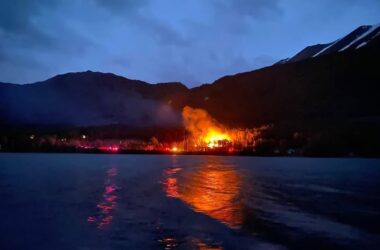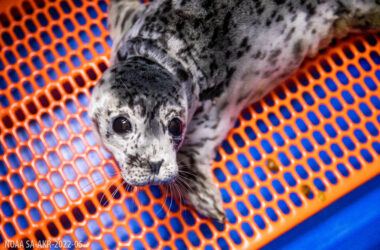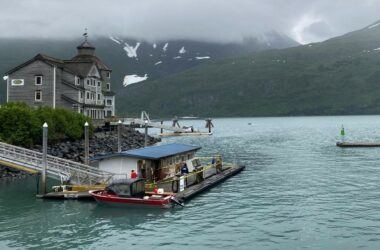The possible re-opening of the Agrium (Nutrien) plant in Nikiski and the construction of the Alaska LNG Project LNG facility in Nikiski, has come back to the fore-front as the Alaska Gasline Development Corp. (AGDC) announced submission of a concept paper for an Alaska Hydrogen Hub to the U.S. Department of Energy (DOE).
KSRM news has developed a two-part series on the AGDC plan for a natural gas pipeline and Agrium’s role in the development of the Nikiski area as a Hydrogen Hub for the United States.
Alaska Gasline Development Corp. President Frank Richards, in an interview with KSRM, explained the many facets of the natural gas development process. Part one of the series introduces the gas market and plan for Agrium in conjunction with a gas pipeline.
Richards on Alaska as natural gas Hydrogen hub…
“Alaska with our abundance of natural gas specifically the natural gas that will be provided through the Alaska LNG Pipeline Project will be utilizing the existing Nutrien (Agrium) plant, that’s been mothballed since the early 2000’s. We’ve been working collaboratively with Nutrien and now with a group of other organizations to be able to try and identify that Alaska specifically can meet the goal as well as the criteria that the Department of Energy is looking at to land a Hydrogen Hub in Alaska.”
Richards further explained the concept of the Alaska LNG Project;
“ The concept called the Alaska LNG Project, the re-start of the Nutrien (Agrium) plant will be predicated on the successful completion and start up of the Alaska LNG Project because that is the project that will be able to tap into the natural gas on the North Slope, bring it down through the pipeline to Alaskans along the right-of-way and terminate in Nikiski where a portion of the gas could be provided to Nutrien or other new ammonia start-ups. In addition to providing gas to the liquefaction facility export as a major commodity.”
Richards stressed importance of funding sources, and private sector developers to the projects advancement;
“ We continue to work and look for private sector developers, or financial institutions or international oil companies to be able to come on and take our the leadership role of the project. The Alaska Gasline Development Corp. is a state corporation that was created by the legislature and given the responsibility to shepherd this project through for the state. We don’t have the resource, the financial capabilities nor do we have the expertise to be able to build a $40 billion project. There are entities out there that are keenly looking at this project because of our proximity to the Asian markets, because of the ability to provide low carbon LNG production, for the ability to provide hydrogen for another fuel source associated with the project. We find ourselves in a position right now engaging in commercial discussions with those private sector parties. Our goal, I will tell you is to be able to bring on those investors in 2022, haven’t been able to successful ink those deals yet we are still very hopeful. And be able to star looking at the engineering and design in 2023 with the final investment decision in 2024.”
In Part two of KSRM’s series on Alaska Gasline Development Corp. plan for Nikiski as a Hydrogen Hub, AGDC President Frank Richards further explains Agrium’s role in proposal.
Richards discussed modifications and upgrades to the existing Agrium facility;
“ There will be some modifications made to the plant. Certainly, the plant has been sitting idle and they will have to done a thorough analysis to determine what. If any, components need to be replaced. The initial scope of this will be to re-start the plant with its existing steam reformers and be able to produce about 600 tons of hydrogen in the form of ammonia per day.” That is almost ten times what the minimum threshold is that the Department of Energy in looking for in a successful project to start. And they were having a minimum target of 50 tons. Even just the restart of the existing plant to produce liquid ammonia will create about 600 tons per day of hydrogen. That we fell gives us a very good leg-up on our competition around the nation. We have a plant sitting idle that is ready to restart.”
Expansion of the Agrium facility is also a goal according to Richards;
“The goal is to also look for the expansion of the plant, so that would bring in new technologies all of thermal reforming which is a new process that would allow for lower production of carbon during the process of creating the ammonia. And ultimately capturing the carbon from that process and then being able to sequester it. And what Cook Inlet has as its benefit is that it has been designated the best carbon sequestration sink-an area that can capture and sequester carbon-on the west coast of North America. That is the clear distinction and that is an opportunity that Alaska could utilize to not only capture carbon through the production of LNG and for ammonia; but also, for other opportunities as well.”
Richards re-stated the submission of a concept paper for an Alaska Hydrogen Hub to the U.S. Department of Energy as part of the goal of the Alaska LNG Project;
“Another step in our progress in terms of bring the Alaska LNG Project through to successful completion and delivery of energy to Alaska as well as the Asian market. Essentially re-starting what Alaska and Nikiski had been providing to the Asian market and to the U.S. mainland itself by production of liquid ammonia and urea. So we think that there’s a great opportunity here.”
For further details on the proposal click here.






